Numerical Investigation of the Effectiveness of Vegetation-Embankment Hybrid Structures for Tsunami Mitigation Introduced after the 2011 Tsunami
Abstract
1. Introduction
2. Computational Model
2.1. Fundamental Equations (Depth-Averaged Non-Linear Long Wave Equations)
Turbulent Flux Term Related to Nonuniformity of Velocity Distribution
2.2. Methods for Solving Fundamental Equations
2.3. Parameters for Evaluating the Effectiveness of Each Hybrid System
2.3.1. Reductions of Fluid Force Index (RFI) and Moment Index (RMI)
2.3.2. Delay in Tsunami Arrival Time (ΔT)
3. Model Validation and Simulated Conditions
3.1. Previous Experiments for Model Validation
3.2. Model Validations for Steady and Unsteady Flow Cases
3.3. Simulated Condition for Generalizing Effects of Hybrid Structures with Changing Wave Characteristics
3.3.1. Production of Different Wave Periods of Surge-Type Flow
3.3.2. Wave Height and Embankment Height Ratio
4. Results
4.1. Effect of Tsunami Wave Period on the Reduction Magnitude by Hybrid Mitigation Systems
4.2. Effects of Tsunami Characteristics on the Rate of Reduction of Overflow Volume (ΔQ)
4.3. Changes in the Time Series of Fluid Force Index (u2h) at G3 for Different Tsunami Periods and Models
4.4. Effects of Tsunami Wave Period and Height on the Maximum Reduction of the Fluid Force Index (RFI) and Moment Index by Fluid Force (RMI)
5. Discussion
5.1. Effective Hybrid Structures and Their Mechanisms
5.2. Changes of the Effectiveness Due to Wave Period and Magnitude
6. Conclusions
- The delay in tsunami arrival time (ΔT) was not affected by the tsunami wave period for both hybrid structures (Case V e40ME and Case EMVe40). However, the effect became smaller with increasing tsunami height and approached that of the cases with only vegetation (Case Ve40NN, Case NN Ve40).
- The rates of reduction of overflow volume (ΔQ), fluid force index (RFI), and moment index (RMI) were decreased with increasing tsunami wave period. Case Ve40ME was effective from the points of ΔT, ΔQ, and RMI. However, the RFI effect just behind the embankment was small when the flow is in a supercritical state. Case EMVe40 was effective from the point of RFI.
- The effect of the tsunami period is related to the time of hydraulic jump development, followed by a backwater rise in front of the vegetation. The water level in between the vegetation and embankment became higher than the water level at the embankment, and ΔQ decreased.
- A moat between the vegetation and embankment is effective for increasing energy reduction and the combined reflection by vegetation, moat, and embankment for the seaward vegetation type. For the landward vegetation type, a moat also plays a role in reducing energy and fluid force. It also can reduce the damage to a forest in the case of an actual forest. If there is no moat in between the systems, space should be provided to increase the combined effects of vegetation and embankment.
- The importance of comparing tsunami periods with the time during which the hydraulic jump develops and the water level increases inside the hybrid structure is elucidated. This greatly affects the quantitative value of the mitigation effects when the tsunami period is smaller than the time to develop the hydraulic jump. Although the quantitative values varied within the numerical simulation condition and wave period range, a hybrid mitigation system comprised of an embankment, moat, and vegetation could be considered an effective design to mitigate an L2 tsunami, especially in Case Ve40ME and Case EMVe40.
Author Contributions
Funding
Institutional Review Board Statement
Informed Consent Statement
Conflicts of Interest
References
- Tappin, D.R.; Evans, H.M.; Jordan, C.J.; Richmond, B.; Sugawara, D.; Goto, K. Coastal changes in the Sendai area from the impact of the 2011 Tōhoku-oki tsunami: Interpretations of time series satellite images, helicopter-borne video footage and field observations. Sediment. Geol. 2012, 282, 151–174. [Google Scholar] [CrossRef]
- Mikami, T.; Shibayama, T.; Esteban, M. Field survey of the 2011 Tohoku earthquake and tsunami in Miyagi and Fukushima Prefectures. Coast. Eng. J. 2012, 54, 1–26. [Google Scholar] [CrossRef]
- Tanaka, N. Effectiveness and limitations of coastal forest in large tsunami: Conditions of Japanese pine trees on coastal sand dunes in tsunami caused by Great East Japan Earthquake. J. Jpn. Soc. Civ. Eng. Ser. B1 2012, 68, 7–15. [Google Scholar] [CrossRef]
- Shuto, N. The effectiveness and limit of tsunami control forests. Coast. Eng. Jpn. 1987, 30, 143–153. [Google Scholar] [CrossRef]
- Harada, K.; Imamura, F. Effects of coastal forest on tsunami hazard mitigation—A preliminary investigation. In Tsunamis: Advances in Natural and Technological Hazards Research; Satake, K., Ed.; Springer: Dordrecht, The Netherlands, 2005; Volume 23. [Google Scholar] [CrossRef]
- Tanaka, N. Vegetation bioshields for tsunami mitigation: Review of effectiveness, limitations, construction, and sustainable management. Landsc. Ecol. Eng. 2009, 5, 71–79. [Google Scholar] [CrossRef]
- Yanagisawa, H.; Koshimura, S.; Goto, K.; Miyagi, T.; Imamura, F.; Ruangrassamee, A.; Tanavud, C. The reduction effects of mangrove forest on a tsunami based on field surveys at Pakarang Cape, Thailand and numerical analysis. Estuar. Coast. Shelf Sci. 2009, 81, 27–37. [Google Scholar] [CrossRef]
- Strusinska-Correia, A. Tsunami mitigation in Japan after the 2011 Tohoku Tsunami. Int. J. Disaster Risk Reduct. 2017, 22, 397–411. [Google Scholar] [CrossRef]
- Otsuchi Town. Forest for Reposing of Souls. Available online: https://www.town.otsuchi.iwate.jp/fs/1/9/3/2/4/4/_/honbun.pdf (accessed on 22 October 2021). (In Japanese).
- Zaha, T.; Tanaka, N.; Kimiwada, Y. Flume experiments on optimal arrangement of hybrid defense system comprising an embankment, moat, and emergent vegetation to mitigate inundating tsunami current. Ocean Eng. 2019, 173, 45–57. [Google Scholar] [CrossRef]
- Matsuba, S.; Mikami, T.; Jayaratne, R.; Shibayama, T.; Esteban, M. Analysis of tsunami behavior and the effect of coastal forest in reducing tsunami force around the coastal dikes. Coast. Eng. Proc. 2014, 1, 37. [Google Scholar] [CrossRef]
- Igarashi, Y.; Tanaka, N. Effectiveness of a compound defense system of sea embankment and coastal forest against a tsunami. Ocean Eng. 2018, 151, 246–256. [Google Scholar] [CrossRef]
- Usman, F.; Murakami, K.; Kurniawan, E.B. Study on reducing tsunami inundation energy by the modification of topography based on local wisdom. Proc. Environ. Sci. 2014, 20, 642–650. [Google Scholar] [CrossRef][Green Version]
- Rahman, M.M.; Schaab, C.; Nakaza, E. Experimental and numerical modeling of tsunami mitigation by canals. J. Waterw. Port Coast. Ocean Eng. 2016, 143, 04016012. [Google Scholar] [CrossRef]
- Mineura, R.; Tsujimoto, G.; Yamada, F. A study on scouring by overflow from seawall and application of an artificial trench. J. Jpn. Soc. Civ. Eng. Ser. B2 (Coast. Eng.) 2013, 69, 791–795. [Google Scholar]
- Tsujimoto, G.; Mineura, R.; Yamada, F.; Kakinoki, T.; Uno, K. Scouring mechanism behind seawall from tsunami overflow and optimum conditions to reduce tsunami energy with an artificial trench. Coast. Eng. Proc. 2015, 1, 38. [Google Scholar] [CrossRef]
- Chow, V.T. Open-Channel Hydraulics; McGraw-Hill: New York, NY, USA, 1959; p. 728. [Google Scholar]
- Hager, W.H. B-jump in sloping channel. J. Hydraul. Res. 1988, 26, 539–558. [Google Scholar] [CrossRef]
- Thuy, N.B.; Nandasena, N.A.K.; Dang, V.H.; Tanaka, N. Simplified formulae for designing coastal forest against tsunami run-up: One-dimensional approach. Nat. Hazards 2018, 92, 327–346. [Google Scholar] [CrossRef]
- Vinodh, T.L.C.; Tanaka, N. A unified runup formula for solitary waves on a plane beach. Ocean Eng. 2020, 216, 108038. [Google Scholar] [CrossRef]
- Ali Hasan Muhammad, R.; Tanaka, N. Energy Reduction of a Tsunami Current through a Hybrid Defense System Comprising a Sea Embankment Followed by a Coastal Forest. Geosciences 2019, 9, 247. [Google Scholar] [CrossRef]
- Kimiwada, Y.; Tanaka, N.; Zaha, T. Differences in effectiveness of a hybrid tsunami defense system comprising an embankment, moat, and forest in submerged, emergent, or combined conditions. Ocean Eng. 2020, 208, 107457. [Google Scholar] [CrossRef]
- Dissanayaka, K.D.C.R.; Tanaka, N.; Vinodh, T.L.C. Integration of Eco-DRR and hybrid defense system on mitigation of natural disasters (Tsunami and Coastal Flooding): A review. Nat. Hazards 2021, 1–28. [Google Scholar] [CrossRef]
- De Costa, R.; Tanaka, N. Role of hybrid structures on the control of tsunami induced Large Driftwood. Coast. Eng. 2021, 163, 103798. [Google Scholar] [CrossRef]
- Wanger, T.C.; Ainun, N.; Brook, B.W.; Friess, D.A.; Oh, R.R.; Rusdin, A.; Smithers, S.; Tjoa, A. Ecosystem-Based Tsunami Mitigation for Tropical Biodiversity Hotspots. Trends Ecol. Evol. 2020, 35, 96–100. [Google Scholar] [CrossRef]
- Takagi, H. “Adapted mangrove on hybrid platform”—Coupling of ecological and engineering principles against coastal hazards. Results Eng. 2019, 4, 100067. [Google Scholar] [CrossRef]
- Lynett, P.J. Effect of a shallow water obstruction on long wave runup and overland flow velocity. J. Waterw. Port Coast. Ocean Eng. 2007, 133, 455–462. [Google Scholar] [CrossRef]
- Khan, A.A.; Steffler, P.M. Physically based hydraulic jump model for depth averaged computations. J. Hydraul. Eng. 1996, 122, 540–548. [Google Scholar] [CrossRef]
- Thuy, N.B.; Tanimoto, K.; Tanaka, N.; Harada, K.; Iimura, K. Effect of open gap in coastal forest on tsunami run-up—Investigations by experiment and numerical simulation. Ocean Eng. 2009, 36, 1258–1269. [Google Scholar] [CrossRef]
- Iwasaki, T.; Mano, A. Two-dimensional numerical simulation of tsunami run-ups in the Eulerian description. In Proceedings of the 26th Coastal Engineering Conference, JSCE, Kagoshima, Japan, November 1979; pp. 70–72. (In Japanese). [Google Scholar]
- Tanaka, N.; Yasuda, S.; Iimura, K.; Yagisawa, J. Comparison of the effects of coastal forest and those of sea embankment on reducing the washout region of houses in the tsunami caused by the Great East Japan Earthquake. J. Hydro-Environ. Res. 2014, 8, 270–280. [Google Scholar] [CrossRef]
- Tanaka, N.; Yagisawa, J.; Yasuda, S. Breaking pattern and critical breaking condition of Japanese pine trees on coastal sand dunes in huge tsunami caused by Great East Japan Earthquake. Nat. Hazards 2013, 65, 423–442. [Google Scholar] [CrossRef]
- Yeh, H.; Ghazali, A.; Marton, I. Experimental study of bore run-up. J. Fluid Mech. 1989, 206, 563–578. [Google Scholar] [CrossRef]
- Tanaka, N.; Igarashi, Y. Multiple defense for tsunami inundation by two embankment system and prevention of oscillation by trees on embankment. In Proceedings of the 20th Congress of IAHR APD Congress [CD-ROM], APD-IAHR2016, Colombo, Sri Lanka, 28–31 August 2016. [Google Scholar]
- Rahman, M.A.; Tanaka, N.; Rashedunnabi, A.H.M. Flume experiments on flow analysis and energy reduction through a compound tsunami mitigation system with a seaward embankment and landward vegetation over a mound. Geosciences 2021, 11, 90. [Google Scholar] [CrossRef]
- Adam, A.M.; Ruff, J.F.; AlQaser, G.; Abt, S.R. Characteristics of B-jump with different toe locations. J. Hydraul. Eng. 1993, 119, 938–948. [Google Scholar] [CrossRef]
- Kawagoshi, N.; Hager, W.H. B-jump in sloping channel, II. J. Hydraul. Res. 1990, 28, 461–480. [Google Scholar] [CrossRef]
- Tokida, K.; Tanimoto, R. Lessons for countermeasures using earth structures against tsunami obtained in the 2011 off the Pacific coast of Tohoku earthquake. Soils Found. 2014, 54, 523–543. [Google Scholar] [CrossRef]
- Tanaka, N.; Sato, M. Scoured depth and length of pools and ditches generated by overtopping flow from embankments during the 2011 Great East Japan Tsunami. Ocean Eng. 2015, 109, 72–82. [Google Scholar] [CrossRef]
- Rahman, M.A.; Tanaka, N.; Reheman, N. Experimental study on reduction of scouring and tsunami energy through a defense system consisting a seaward embankment followed by vertically double layered vegetation. Ocean Eng. 2021, 234, 108816. [Google Scholar] [CrossRef]
- Igarashi, Y.; Tanaka, N. Tsunami mitigation effect and tree breaking situation of Dahurian Larch coastal forest at six growth stages under thinning management of trees. In Proceedings of the IAHR 38th Congress, Panama City, Panama, 1–6 September 2019; pp. 219–229. [Google Scholar]
- Baba, T.; Takahashi, N.; Kaneda, Y.; Ando, K.; Matsuoka, D.; Kato, T. Parallel implementation of dispersive tsunami wave modeling with a nesting algorithm for the 2011 Tohoku tsunami. Pure Appl. Geophys. 2015, 172, 3455–3472. [Google Scholar] [CrossRef]
- Roeber, V.; Bricker, J.D. Destructive tsunami-like wave generated by surf beat over a coral reef during Typhoon Haiyan. Nat. Commun. 2015, 6, 1–9. [Google Scholar] [CrossRef]


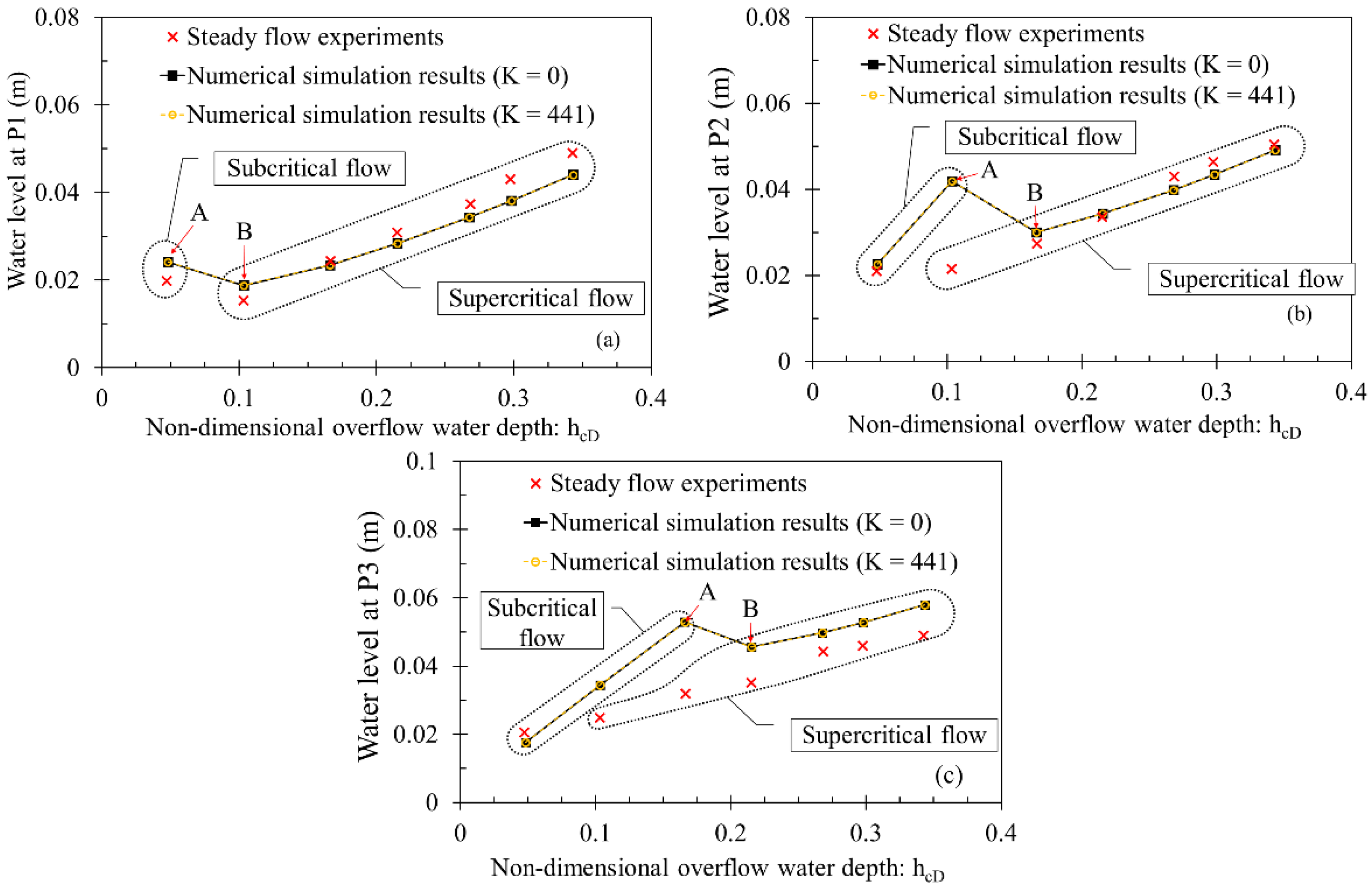

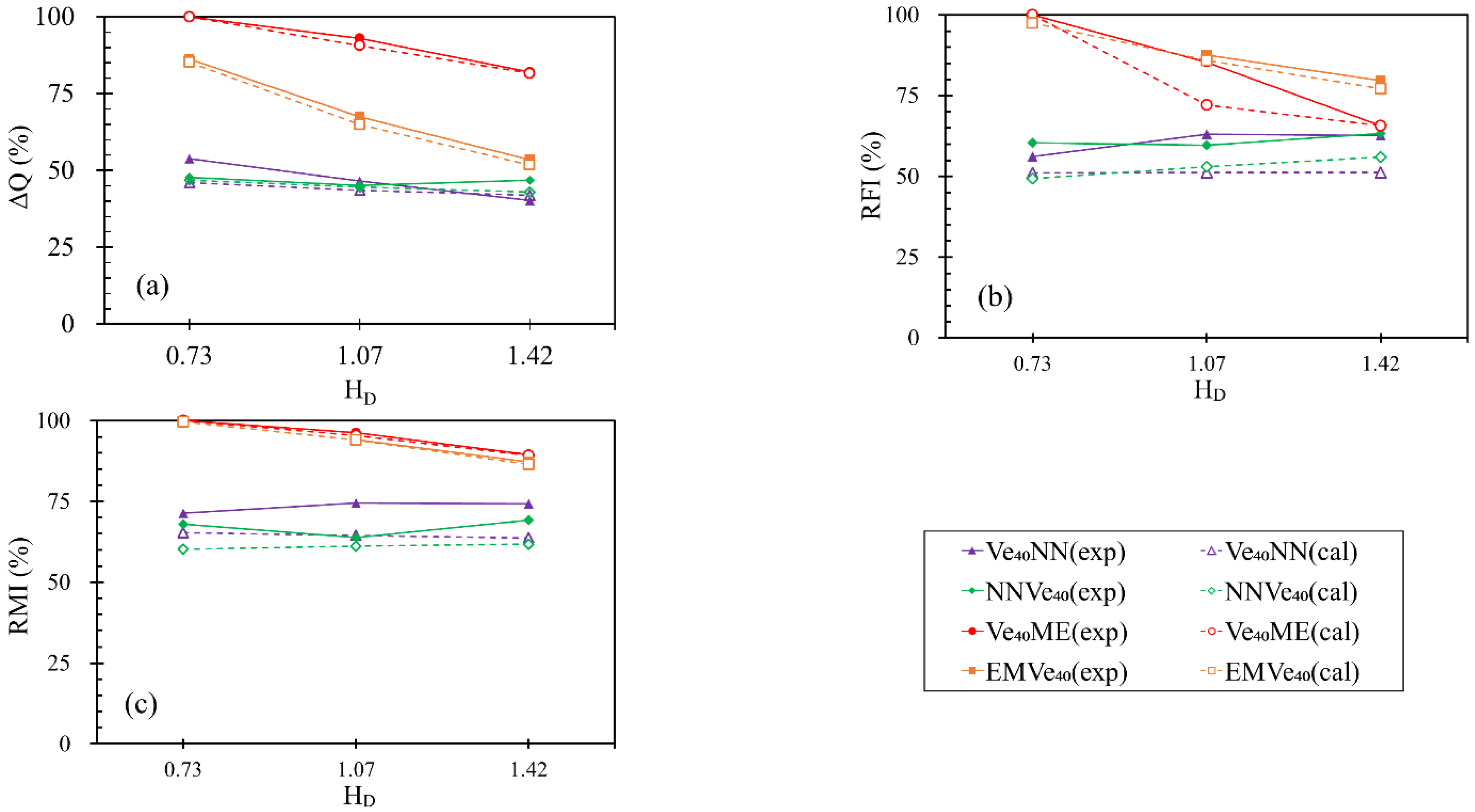
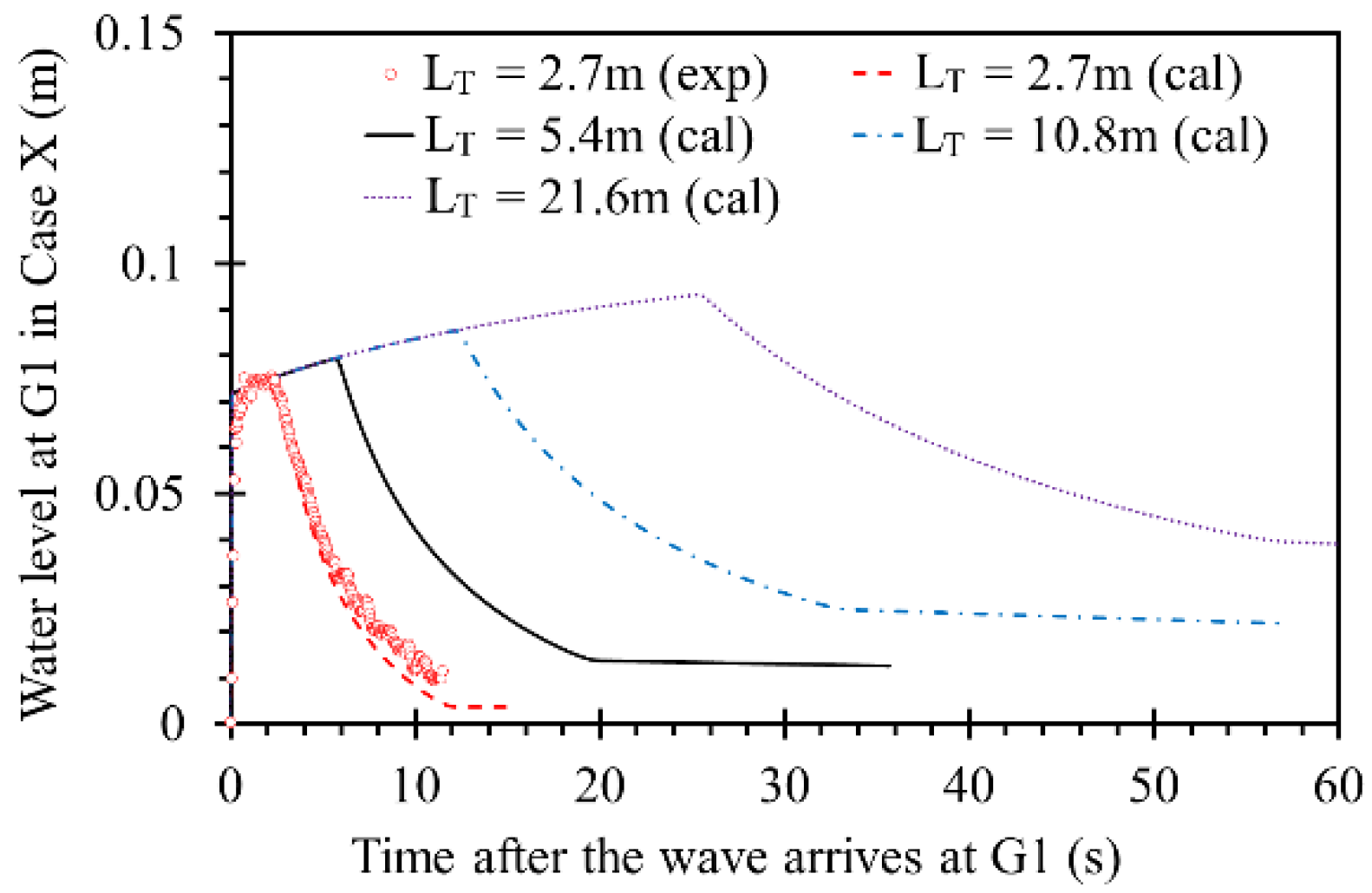




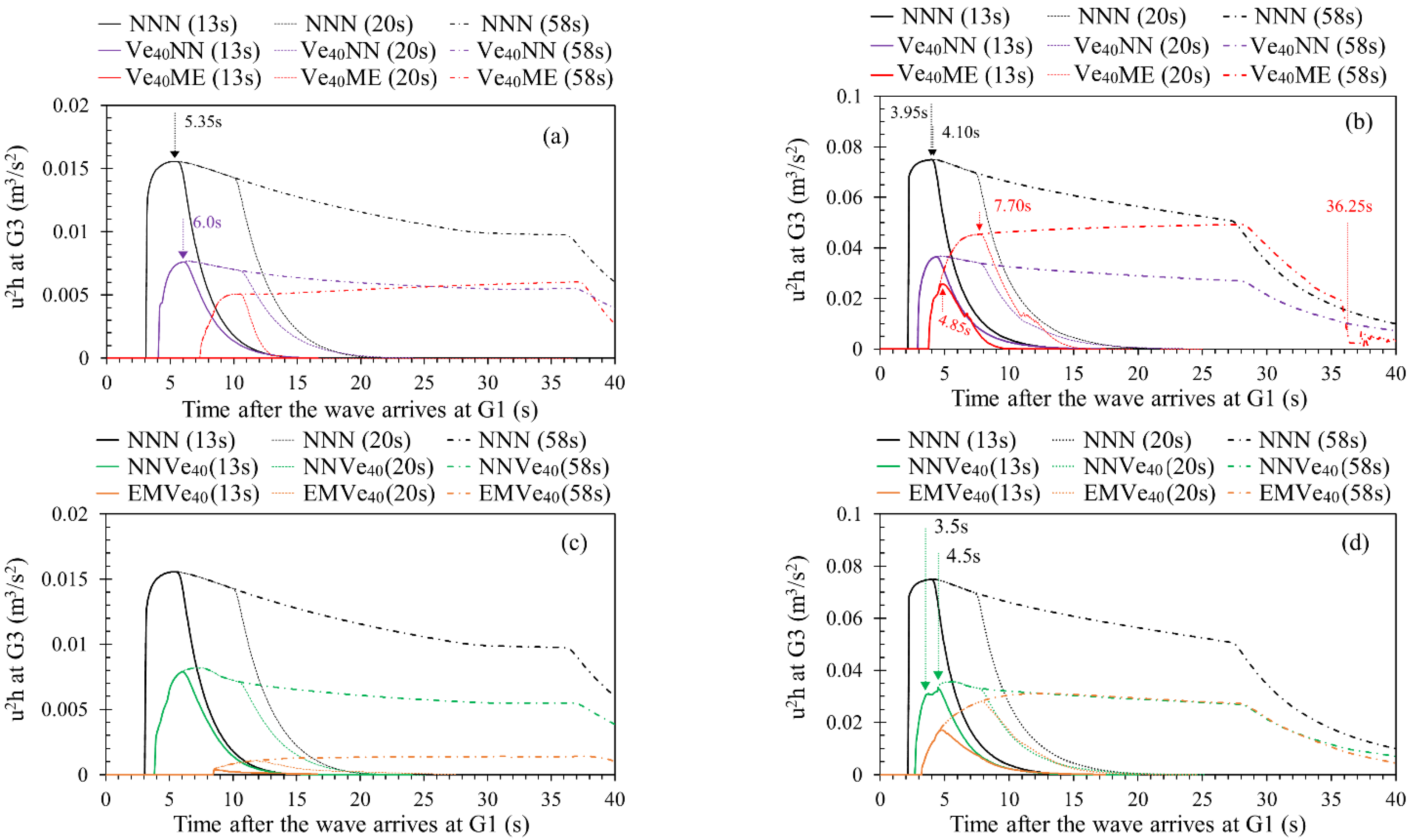
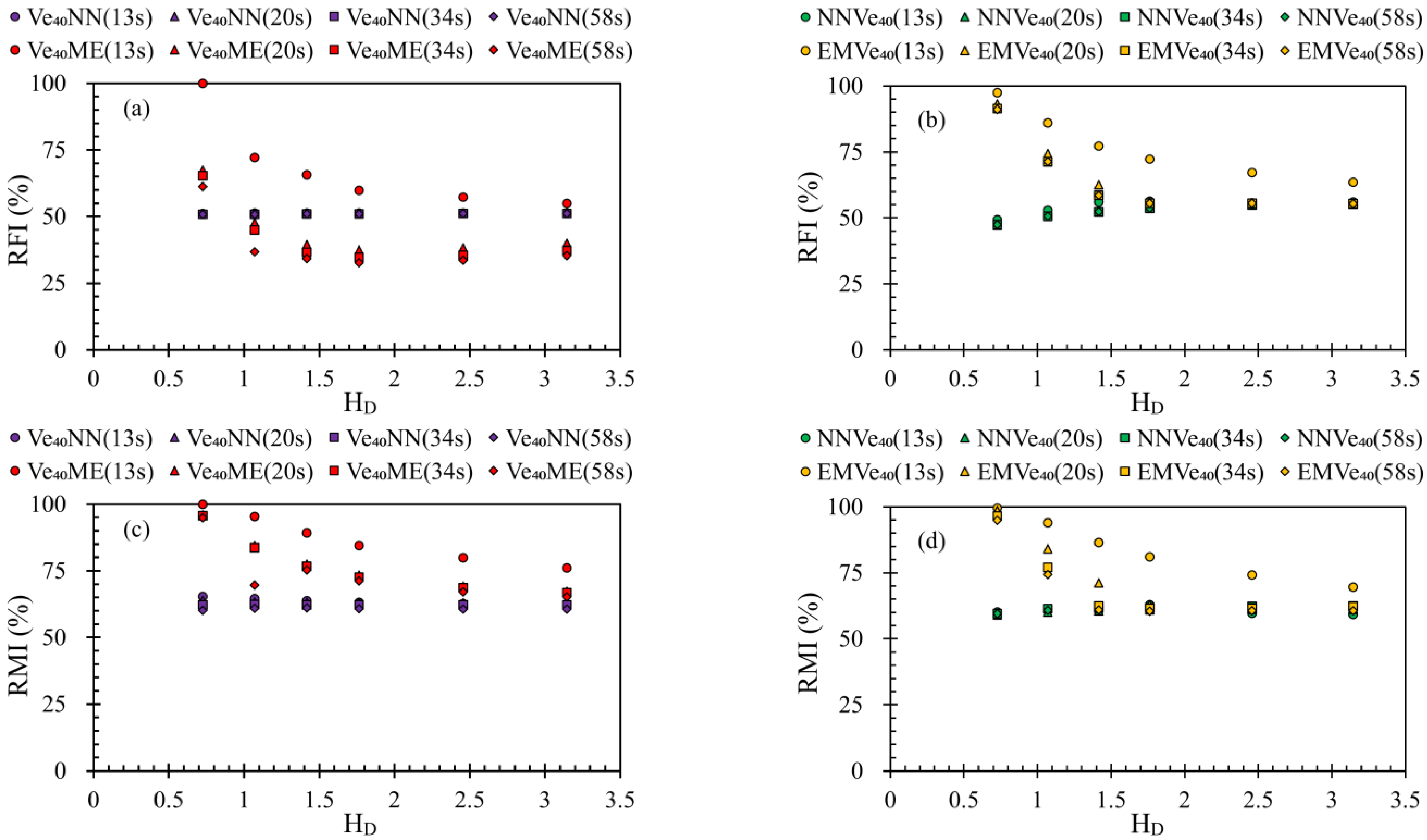
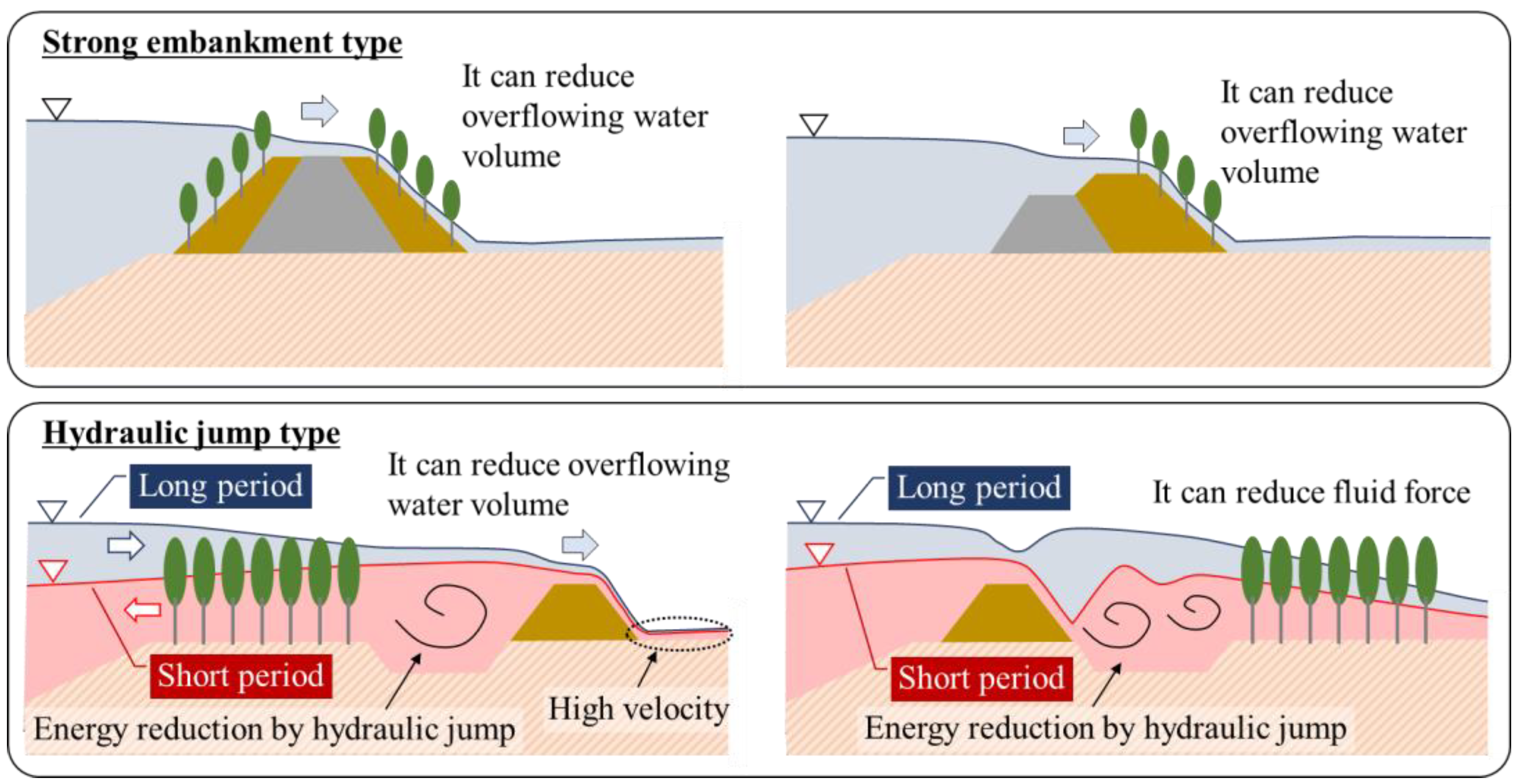
| Case | Flow Condition | K (Constant Related to the Hydraulic Jump) | Non-Dimensional Overflow Water Depth: hcD | Non-Dimensional Wave Height: HD | Wave Period (s) |
|---|---|---|---|---|---|
| E | Steady flow | 0, 441 | 0.048, 0.103, 0.166, 0.215, 0.268, 0.298, 0.343 | - | - |
| X | Unsteady flow | 441 | - | 0.73, 1.07, 1.42, 1.76, 2.46, 3.15 | 13, 21, 34, 58 |
| NNN | Unsteady flow | 441 | - | 0.73, 1.07, 1.42, 1.76, 2.46, 3.15 | 13, 21, 34, 58 |
| Ve40NN | Unsteady flow | 441 | - | 0.73, 1.07, 1.42, 1.76, 2.46, 3.15 | 13, 21, 34, 58 |
| NNVe40 | Unsteady flow | 441 | - | 0.73, 1.07, 1.42, 1.76, 2.46, 3.15 | 13, 21, 34, 58 |
| ENVe40 | Unsteady flow | 441 | - | 0.73, 1.07, 1.42, 1.76, 2.46, 3.15 | 13, 21, 34, 58 |
| Ve40NE | Unsteady flow | 441 | - | 0.73, 1.07, 1.42, 1.76, 2.46, 3.15 | 13, 21, 34, 58 |
Publisher’s Note: MDPI stays neutral with regard to jurisdictional claims in published maps and institutional affiliations. |
© 2021 by the authors. Licensee MDPI, Basel, Switzerland. This article is an open access article distributed under the terms and conditions of the Creative Commons Attribution (CC BY) license (https://creativecommons.org/licenses/by/4.0/).
Share and Cite
Tanaka, N.; Igarashi, Y.; Zaha, T. Numerical Investigation of the Effectiveness of Vegetation-Embankment Hybrid Structures for Tsunami Mitigation Introduced after the 2011 Tsunami. Geosciences 2021, 11, 440. https://doi.org/10.3390/geosciences11110440
Tanaka N, Igarashi Y, Zaha T. Numerical Investigation of the Effectiveness of Vegetation-Embankment Hybrid Structures for Tsunami Mitigation Introduced after the 2011 Tsunami. Geosciences. 2021; 11(11):440. https://doi.org/10.3390/geosciences11110440
Chicago/Turabian StyleTanaka, Norio, Yoshiya Igarashi, and Takehito Zaha. 2021. "Numerical Investigation of the Effectiveness of Vegetation-Embankment Hybrid Structures for Tsunami Mitigation Introduced after the 2011 Tsunami" Geosciences 11, no. 11: 440. https://doi.org/10.3390/geosciences11110440
APA StyleTanaka, N., Igarashi, Y., & Zaha, T. (2021). Numerical Investigation of the Effectiveness of Vegetation-Embankment Hybrid Structures for Tsunami Mitigation Introduced after the 2011 Tsunami. Geosciences, 11(11), 440. https://doi.org/10.3390/geosciences11110440






